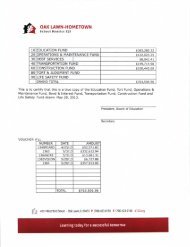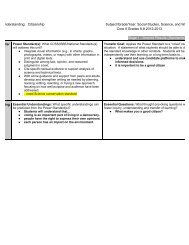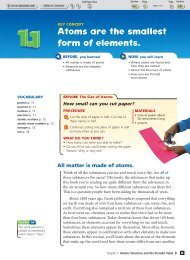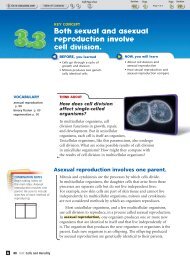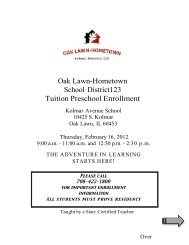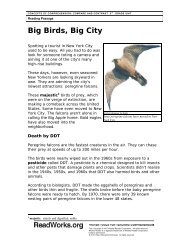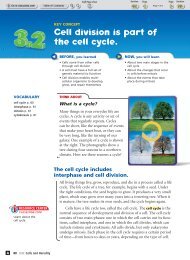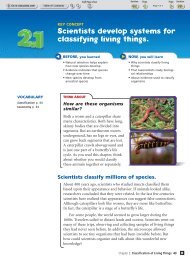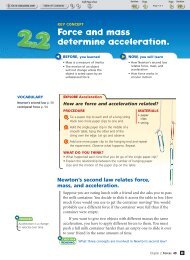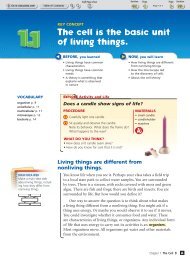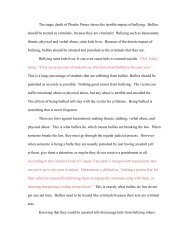Ratio and Proportional Relationships UbD Unit
Ratio and Proportional Relationships UbD Unit
Ratio and Proportional Relationships UbD Unit
You also want an ePaper? Increase the reach of your titles
YUMPU automatically turns print PDFs into web optimized ePapers that Google loves.
<strong>Unit</strong> Underst<strong>and</strong>ing: <strong>Ratio</strong> & <strong>Proportional</strong> <strong>Relationships</strong> Subject/Grade/Year: 6th grade Math<br />
Stage 1 - Desired Results (St<strong>and</strong>ards)<br />
T<br />
r<br />
a<br />
n<br />
s<br />
f<br />
e<br />
r<br />
Power St<strong>and</strong>ard(s): What CCSS/ISBE/National St<strong>and</strong>ards(s)<br />
will address this unit?<br />
CC.6.RP.1 Underst<strong>and</strong> ratio concepts <strong>and</strong> use ratio reasoning to<br />
solve problems. Underst<strong>and</strong> the concept of a ratio <strong>and</strong> use ratio<br />
language to describe a ratio relationship between two quantities.<br />
CC.6.RP.2 Underst<strong>and</strong> ratio concepts <strong>and</strong> use ratio reasoning<br />
to solve problems. Underst<strong>and</strong> the concept of a unit rate a/b<br />
associated with a ratio a:b with b ≠ 0 (b not equal to zero), <strong>and</strong><br />
use rate language in the context of a ratio relationship.<br />
CC.6.RP.3a Make tables of equivalent ratios relating quantities<br />
with whole-number measurements, find missing values in the<br />
tables, <strong>and</strong> plot the pairs of values on the coordinate plane. Use<br />
tables to compare ratios.<br />
CC.6.RP.3b Solve unit rate problems including those involving<br />
unit pricing <strong>and</strong> constant speed.<br />
CC.6EE.6 Use variables to represent numbers <strong>and</strong> write<br />
expressions when solving a real-world or mathematical problem;<br />
underst<strong>and</strong> that a variable can represent an unknown number,<br />
or, depending on the purpose at h<strong>and</strong>, any number in a specified<br />
set.<br />
CC.6.EE.9 Represent <strong>and</strong> analyze quantitative relationships<br />
between dependent <strong>and</strong> independent variables. Use variables<br />
to represent two quantities in a real-world problem that change<br />
in relationship to one another; write an equation to express one<br />
quantity, thought of as the dependent variable, in terms of the<br />
other quantity, thought of as the independent variable. Analyze<br />
the relationship between the dependent <strong>and</strong> independent<br />
variables using graphs <strong>and</strong> tables, <strong>and</strong> relate these to the<br />
equation.<br />
CC.6.NS.4 Compute fluently with multi-digit numbers <strong>and</strong> find<br />
common factors <strong>and</strong> multiples. Find the greatest common factor<br />
of two whole numbers less than or equal to 100 <strong>and</strong> the least<br />
common multiple of two whole numbers less than or equal to 12.<br />
Transfer Goal: Applies the Power St<strong>and</strong>ard to a “novel” real world<br />
situation. A statement of what students should be able to do with<br />
the st<strong>and</strong>ard knowledge in other contexts. Students will be able to<br />
independently use their learning on a long-term basis to...<br />
● Apply ratios <strong>and</strong> rates to different situations, such as unit pricing<br />
<strong>and</strong> constant speed.
M<br />
e<br />
a<br />
n<br />
i<br />
n<br />
g<br />
Essential Underst<strong>and</strong>ings: What specific underst<strong>and</strong>ings can<br />
be predicted from the Power St<strong>and</strong>ard(s)?<br />
● Students will underst<strong>and</strong> that a proportion involves<br />
multiplicative thinking, not additive.<br />
● Students will underst<strong>and</strong> that ratios compare two<br />
quantities.<br />
Essential Questions: What thought provoking questions would foster<br />
inquiry, underst<strong>and</strong>ing <strong>and</strong> transfer of learning?<br />
How can we model, represent <strong>and</strong> tell the difference between rates <strong>and</strong><br />
ratios?<br />
A<br />
c<br />
q<br />
u<br />
i<br />
s<br />
i<br />
t<br />
i<br />
o<br />
n<br />
Knowledge: What should students know as a result of this unit?<br />
What can be studied? (Theory/Concepts/Mental Coordination)<br />
●<br />
●<br />
●<br />
●<br />
●<br />
●<br />
●<br />
●<br />
●<br />
I can underst<strong>and</strong> a ratio as a way to compare two<br />
quantities.<br />
I can use ratio language to describe ratio relationships.<br />
I can underst<strong>and</strong> a unit rate of a:b as a ratio of a:b.<br />
I can solve unit rate problems involving unit pricing.<br />
I can make a table of equivalent ratios.<br />
I can determine missing values in a table of equivalent<br />
ratios.<br />
I can use tables to compare ratios.<br />
I can plot pairs of values on a coordinate plane.<br />
I can solve unit rate problems involving constant speed.<br />
Skills: What should students be able to do as a result of this unit?<br />
What can be practiced? (Application of Theory/Concepts/Physical<br />
Coordination)<br />
●<br />
●<br />
Students will be able to define ratio as a distinctive relationship<br />
between two pieces of data.<br />
Students will be able to create <strong>and</strong> manipulate ratios <strong>and</strong> utilize<br />
ratio language to problem solve (find & apply unit rates, create,<br />
extend & graph tables).<br />
Stage 2 - Evidence
Summative Performance Assessment(s): Is each st<strong>and</strong>ard <strong>and</strong> transfer goal being assessed? An authentic assessment(s) designed to show<br />
how students demonstrate their underst<strong>and</strong>ing of essential questions <strong>and</strong> transfer goals when applied to a new, varied, or realistic situation.<br />
Should be written in the GRASPS format <strong>and</strong> reflect the <strong>UbD</strong> “Six Facets of Underst<strong>and</strong>ing”.<br />
●<br />
●<br />
Complete a table of proportional values (not in order), find unit rate, graph results, use graph to predict, make a general statement about<br />
what is happening in the table/graph (rule).<br />
Write a letter to the person who shops <strong>and</strong> prepares meals for your family. In it explain how using ratios might assist them in saving<br />
money or prepare the right amount of food. Cite two different <strong>and</strong> specific examples using the words per, for every, each, unit rate, ratio,<br />
rate (i.e. buying an item in bulk as opposed to a more convenient size, planning a large dinner).<br />
○ Rubric?<br />
Assessment Criteria: What criteria will be used in each assessment to evaluate attainment of each desired result? What are the qualities by<br />
which learning is judged? Think rubric components!!! (Content, Process, Product, knowledge, skill)<br />
Constructively aligned assessment criteria begin with a noun that complements the verb in the assessment tasks objective. If the objective is for<br />
students to "explain how concepts in the subject interrelate" one of the criteria might be "Clarity of explanation". That is, the criterion describes<br />
the quality in the assessment task that will be judged as an assessment. Other commonly used quality words used in criteria include: Accuracy,<br />
Currency, Depth, Impact, Legibility, Originality, Succinctness, <strong>and</strong> Relevance.<br />
●
Formative Assessment Evidence: What daily evidence has been collected to determine goal attainment? Tests, quizzes, discussions,<br />
homework, exit slips, graphic organizers, note-taking, etc…<br />
Pre-assessment:<br />
● Timed Test: Multiplication<br />
● Math Talk/Socrative/Warm-Up: Point plotting/giving coordinates<br />
● Using a table with a given unit rate, determine unknown values of equivalent ratios<br />
Formative Assessments:<br />
● Recess Games<br />
● Using a table with a given unit rate, determine unknown values of equivalent ratios, state rule that makes the two quantities relate<br />
● Given a ratio, determine its unit rate <strong>and</strong> use this information to answer questions about better buy, speed, etc..<br />
● MARS Task - Cans of Kola<br />
Stage 3 - Learning Plan (Activity)<br />
Pre-Assessment: What will be done to determine students’ background knowledge, skill level, <strong>and</strong> possible misconceptions? (K-W-L) How will<br />
students be grouped? What opportunities for differentiation will take place?<br />
● Multiplication Timed Test - repeat periodically<br />
·
Aligned Learning Activities: What will be done each day to foster student success at transfer, meaning, <strong>and</strong> acquisition? How will critical<br />
thinking, problem solving, <strong>and</strong> systems thinking be incorporated? Consider the “Gradual Release of Responsibility Model” <strong>and</strong> “WHERETO”<br />
format when developing daily experiences linked to Stages 1 <strong>and</strong> 2.<br />
Date(s)<br />
“We Will…” Objective:<br />
How are action verbs<br />
used to link content to the<br />
Power St<strong>and</strong>ard for each<br />
learning experience?<br />
Procedures:<br />
What is the daily lesson plan process? What is the step-bystep<br />
path of learning? How are learning activities prioritized<br />
<strong>and</strong> sequenced in an engaging <strong>and</strong> time sensitive manner?<br />
How are learning experiences differentiated or modified to meet<br />
assessed learning needs? How are the daily products connected to<br />
Summative Performance Tasks?<br />
Progress Monitoring:<br />
How is progress toward transfer,<br />
meaning, <strong>and</strong> acquisition regularly<br />
monitored?<br />
What are the misunderst<strong>and</strong>ings?<br />
How will students receive relevant<br />
feedback?
Social Studies:<br />
Science:<br />
P.E.:<br />
Health:<br />
Art:<br />
Incorporate scale activities (Hot on the Trail/Sundae Delivery)<br />
Latitude/Longitude (desk maps)<br />
Food Webs <strong>and</strong> Food Chains - calories burned moving through the<br />
food chain<br />
Heart rate<br />
Nutritional values<br />
Scale drawings<br />
●<br />
●<br />
I can underst<strong>and</strong><br />
a ratio as a way<br />
to compare two<br />
quantities.<br />
I can use ratio<br />
language to<br />
describe ratio<br />
relationships.<br />
For daily consideration...<br />
● Timed Test: Need to be able to multiply<br />
● Math Talk/Socrative/Warm-Up: Point plotting/giving<br />
coordinates<br />
Math Talk:<br />
Display ratio drawings (Van de Walle pg 302) <strong>and</strong> ask students to<br />
make comparisons among the objects shown<br />
Extension: Are any two pictures showing the same thing? Match<br />
them up? What are you comparing?<br />
(1st slide - show one picture, then after show all)<br />
Vocabulary: each, per, ratio, every
Explain: The ratio of wings to beaks in the bird house at the zoo<br />
was 2:1.<br />
How can this be represented in a chart? Headings? What is being<br />
compared?<br />
A ratio is the comparison of two quantities or measures. The<br />
comparison can be part-to-whole (ratio of guppies to all fish<br />
in an aquarium) or part-to-part (ratio of guppies to goldfish).<br />
Students need to underst<strong>and</strong> each of these ratios when<br />
expressed in the following forms: 6/15 , 6 to 15, or 6:15.<br />
These values can be reduced to 2/5, 2 to 5, or 2:5; however,<br />
students would need to underst<strong>and</strong> how the reduced values<br />
relate to the original numbers.<br />
A chart will be formed to show the relationship. Show how<br />
multiplication <strong>and</strong> division can be used to find ratios.<br />
(can use fish slides from last year)<br />
HW: Express using chart with correct headings. Extend chart for 5<br />
number pairs. Explain in words what is being compared.<br />
For every vote c<strong>and</strong>idate A received, c<strong>and</strong>idate C received nearly<br />
three votes.<br />
Use sentence frames when writing sentences using ratios as<br />
comparison.<br />
Example: For every _____ girls playing soccer, _____ boys played<br />
soccer.<br />
Use iPod <strong>and</strong> Book problems before formative assessment.<br />
Formative Assessment: Recess Games<br />
TUESDAY<br />
● Differentiate or Math Talk using student samples of correct/<br />
incorrect work: students using additive thinking (who<br />
used multiplicative thinking: Chaska & Mika?; students<br />
using incorrect order; student using incorrect format;<br />
underst<strong>and</strong>ing meaning of “difference”<br />
● Fish Slides
● I can underst<strong>and</strong><br />
a unit rate of a:b<br />
as a ratio of a:b.<br />
●<br />
●<br />
I can derive a unit<br />
rate from a given<br />
ratio.<br />
I can solve unit<br />
rate problems<br />
involving unit<br />
pricing.<br />
WEDNESDAY LATE START<br />
Math Talk:<br />
If the ratio of girls to boys is 2:1 <strong>and</strong> there are 6 people in the room,<br />
how many girls are there? How many boys? (Consider making a<br />
chart <strong>and</strong> exp<strong>and</strong>ing it)<br />
● Refer to examples of unit rate we’ve already seen (trucks,<br />
beaks, hot dogs, laps)<br />
● “Per serving” investigation: HW for Wed.<br />
THURSDAY<br />
● Per Serving Investingation<br />
○ Teacher will model finding <strong>and</strong> using unit rate in a<br />
○<br />
per serving situation (calories per serving)<br />
Students will work in small groups to determine<br />
<strong>and</strong> present to one another their per serving<br />
examples<br />
THURSDAY/FRIDAY/MONDAY<br />
During Compelling Conversation THEN...video (remediation) <strong>and</strong><br />
Bean Bag/Teacher Shortage (advanced)<br />
● 8.2 slides on <strong>Unit</strong> Rate<br />
*Possible Warm-ups/Exit Slips*<br />
● What are some other amounts of boys <strong>and</strong> girls that fit<br />
this ratio? or worded as: If the ratio of girls to boys in the<br />
room (or at the party) is 2:1, make a chart showing different<br />
combinations of boys <strong>and</strong> girls at the party.<br />
● If you paid $75 for 15 hamburgers, how much did each<br />
burger cost? ($5 per hamburger)<br />
● Complete this statement: If a recipe calls for 3 cups of flour<br />
<strong>and</strong> 4 cups of sugar, there is (3/4) cup of flour for each cup<br />
of sugar.<br />
TUESDAY<br />
Writing <strong>Unit</strong> Rates when costing<br />
Mangos for Sale (mangos per $1 or dollars per mango)<br />
● Consider rephrasing question: Which ratio is more<br />
appropriate?<br />
H.W.: Beans for Sale (beans per $1 or dollars per pound)<br />
WEDNESDAY(late start schedule)
Formative Assessment Option: Consider Socrative<br />
If it took 7 hours to mow 4 lawns, then at that rate, how many<br />
lawns could be mowed in 35 hours? At what rate were lawns being<br />
mowed?
● I can solve unit<br />
rate problems<br />
involving unit<br />
pricing. (Better<br />
buy)<br />
Rates, a relationship between two units of measure, can be written<br />
as ratios, such as miles per hour, ounces per gallon <strong>and</strong> students<br />
per bus. For example, 3 cans of pudding cost $2.48 at Store A <strong>and</strong><br />
6 cans of the same pudding costs $4.50 at Store B. Which store<br />
has the better buy on these cans of pudding? Various strategies<br />
could be used to solve this problem:<br />
· A student can determine the unit cost of 1 can of pudding<br />
at each store <strong>and</strong> compare.<br />
· A student can determine the cost of 6 cans of pudding at<br />
Store A by doubling $2.48.<br />
· A student can determine the cost of 3 cans of pudding at<br />
Store B by taking 1⁄2 of $4.50.<br />
Using ratio tables develops the concept of proportion. By<br />
comparing equivalent ratios, the concept of proportional thinking is<br />
developed <strong>and</strong> many problems can be easily solved.<br />
Store A<br />
3 cans 6 cans<br />
$2.48<br />
Store B<br />
6 cans 3 cans<br />
$4.50<br />
THURSDAY<br />
Review Pudding responses<br />
MARS Task: Cans of Kola
●<br />
●<br />
●<br />
●<br />
I can solve unit<br />
rate problems<br />
involving constant<br />
speed.<br />
I can plot pairs<br />
I can determine<br />
missing values<br />
in a table of<br />
equivalent ratios.<br />
I can use tables<br />
to compare ratios.<br />
of values on a<br />
coordinate plane.<br />
FRIDAY<br />
Debrief on Kola Task -address misconceptions<br />
HW:<br />
Pasta Problem (from last year’s slides)<br />
A store sells the same pasta following two ways: 10lbs of bulk<br />
pasta for $15.00 <strong>and</strong> 2 pounds of packaged pasta for $3.98. To<br />
determine which is the better buy, find the unit rate for both types.<br />
Battery Problem (from last year’s slides)<br />
Which of the following is a better buy? 2AA batteries for $1.50 or<br />
6AA batteries for $4.80<br />
Monday: Debrief Pasta & Battery<br />
Monday<br />
Math Talk: Explore Cups of Peanuts: Cups of Chocolate (pg. 4)<br />
Extension: Graph results AND use graph to determine unknown<br />
values.<br />
Tuesday<br />
Math Talk: Running at a Constant Speed<br />
● Use proportions to solve for unknown<br />
● Put data into table<br />
● Graph
● LOOK AT<br />
ALL “I CAN”<br />
STATEMENTS<br />
● I can plot pairs<br />
of values on a<br />
coordinate plane.<br />
Wednesday<br />
Formative Assessment:<br />
Books Unlimited Tables (pg. 3) (have students graph results?)<br />
During MAP testing, work more on constant speed



